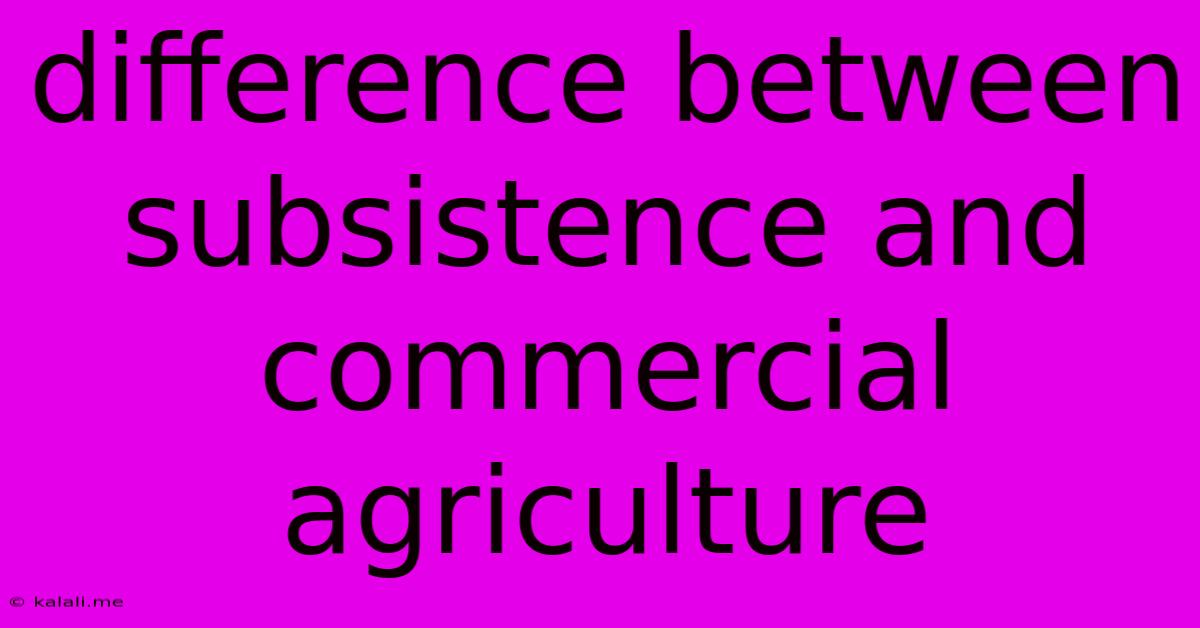Difference Between Subsistence And Commercial Agriculture
Kalali
Jun 12, 2025 · 3 min read

Table of Contents
Subsistence vs. Commercial Agriculture: A Comprehensive Comparison
Understanding the difference between subsistence and commercial agriculture is crucial for comprehending global food systems and economic disparities. While both involve the cultivation of crops and raising of livestock, their motivations, scale, and impact differ significantly. This article delves into the key distinctions between these two fundamental agricultural approaches, exploring their characteristics, benefits, and drawbacks. This will provide a comprehensive overview for anyone interested in agriculture, economics, or global development.
What is Subsistence Agriculture?
Subsistence agriculture is a farming approach where farmers primarily produce food to feed themselves and their families. There's minimal surplus for sale or trade. It's characterized by:
- Small-scale farming: Typically involves small landholdings, often using family labor.
- Traditional methods: Often relies on manual labor and simple tools, with limited use of machinery or technology. Crop rotation and other sustainable practices are common, though technology adoption is limited.
- Diverse crops: Farmers often cultivate a variety of crops to ensure food security and reduce risk. This also helps to maintain soil fertility naturally.
- Limited surplus: Production focuses on meeting immediate needs, with little or no excess for market sale.
- Low capital investment: Investment in land, tools, and inputs is generally low.
- Strong community ties: Often embedded within a close-knit community, with social and economic support networks.
Examples of Subsistence Farming Practices:
- Shifting cultivation: Farmers clear a patch of forest, cultivate it for a few years, and then move to a new area, allowing the previous land to regenerate.
- Pastoral nomadism: Herding livestock across vast areas in search of grazing lands, migrating seasonally.
- Intensive subsistence agriculture: Cultivating small plots intensively using labor-intensive techniques like terracing to maximize yield.
What is Commercial Agriculture?
Commercial agriculture, conversely, aims to produce crops and livestock for sale in the market. It is characterized by:
- Large-scale operations: Often involves large landholdings and significant capital investment.
- Specialized production: Focuses on producing specific crops or livestock for a particular market, maximizing efficiency and profitability. This often leads to monoculture.
- Mechanization and technology: Relies heavily on machinery, technology, and advanced farming techniques to increase productivity and output. This includes things like GPS-guided tractors and precision irrigation.
- Significant surplus: Produces a large surplus for sale, generating income for the farmer.
- High capital investment: Requires substantial investment in land, machinery, technology, and labor.
- Market orientation: Production decisions are driven by market demand and prices.
Examples of Commercial Farming Practices:
- Factory farming: Intensive animal rearing in confined spaces, maximizing output per unit area.
- Large-scale monoculture: Cultivating vast areas with a single crop, optimizing for efficiency and market demand.
- Agribusiness: Large-scale commercial agricultural operations often integrated with processing and distribution networks.
Key Differences Summarized:
| Feature | Subsistence Agriculture | Commercial Agriculture |
|---|---|---|
| Goal | Feed family and community | Generate profit |
| Scale | Small-scale | Large-scale |
| Technology | Traditional methods, limited technology | Advanced technology, mechanization |
| Surplus | Minimal or none | Significant |
| Market Focus | Local or none | Global markets |
| Labor | Primarily family labor | Hired labor, potentially specialized workers |
| Capital | Low | High |
Conclusion:
Subsistence and commercial agriculture represent two distinct approaches to food production. While subsistence farming prioritizes self-sufficiency and community sustenance, commercial agriculture emphasizes efficiency, profit maximization, and global market integration. Understanding these differences is critical for addressing food security challenges, promoting sustainable agricultural practices, and fostering equitable economic development. The ongoing debate about sustainable food production often involves balancing the needs of both systems.
Latest Posts
Latest Posts
-
How Do You Find The Percent Abundance
Jun 13, 2025
-
What Is The Lowest Common Multiple Of 10 And 20
Jun 13, 2025
-
India Is Situated In Which Hemisphere
Jun 13, 2025
-
How Many Shells Does Potassium Have
Jun 13, 2025
-
Free Attention To Detail Test Pdf
Jun 13, 2025
Related Post
Thank you for visiting our website which covers about Difference Between Subsistence And Commercial Agriculture . We hope the information provided has been useful to you. Feel free to contact us if you have any questions or need further assistance. See you next time and don't miss to bookmark.